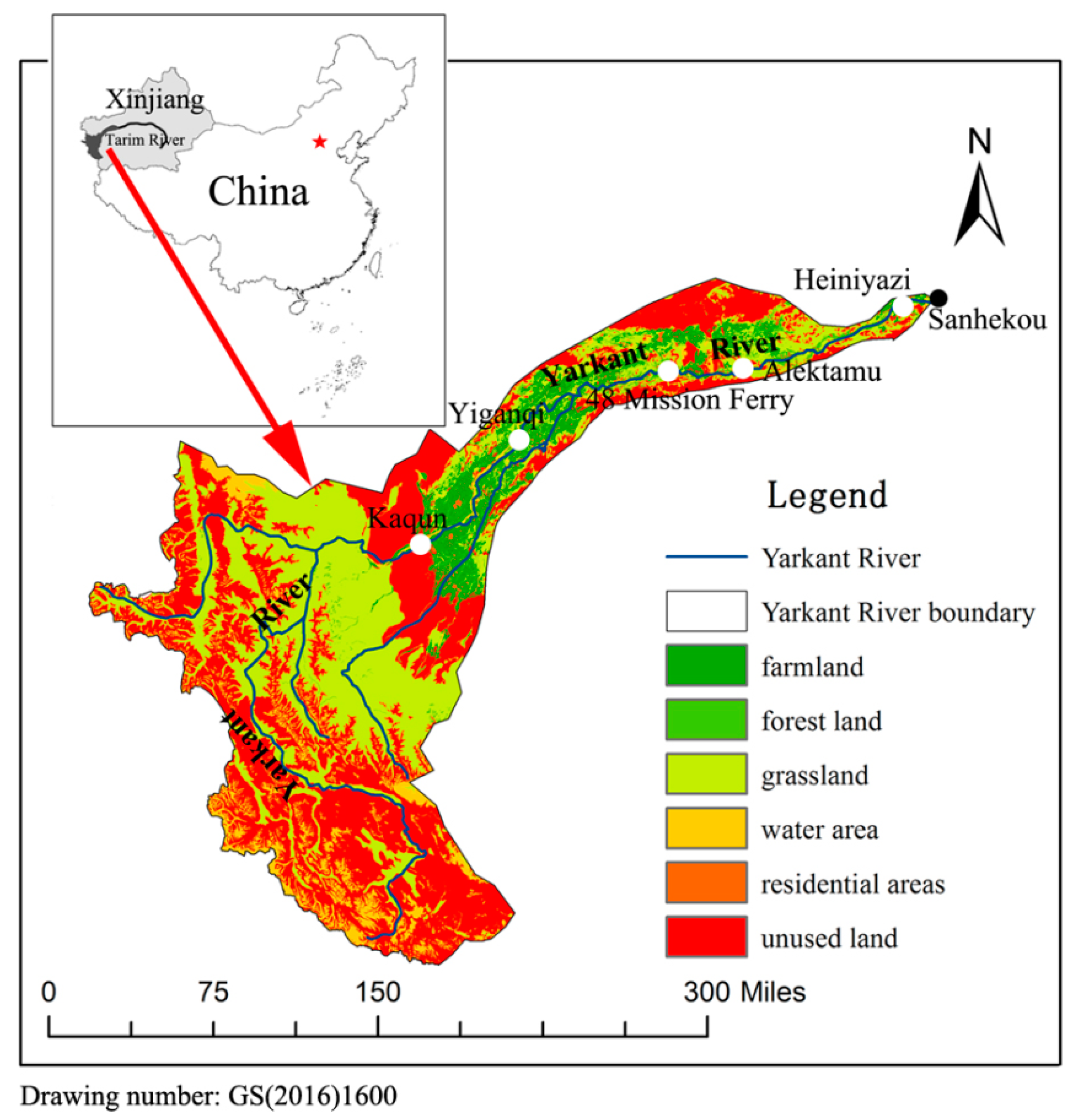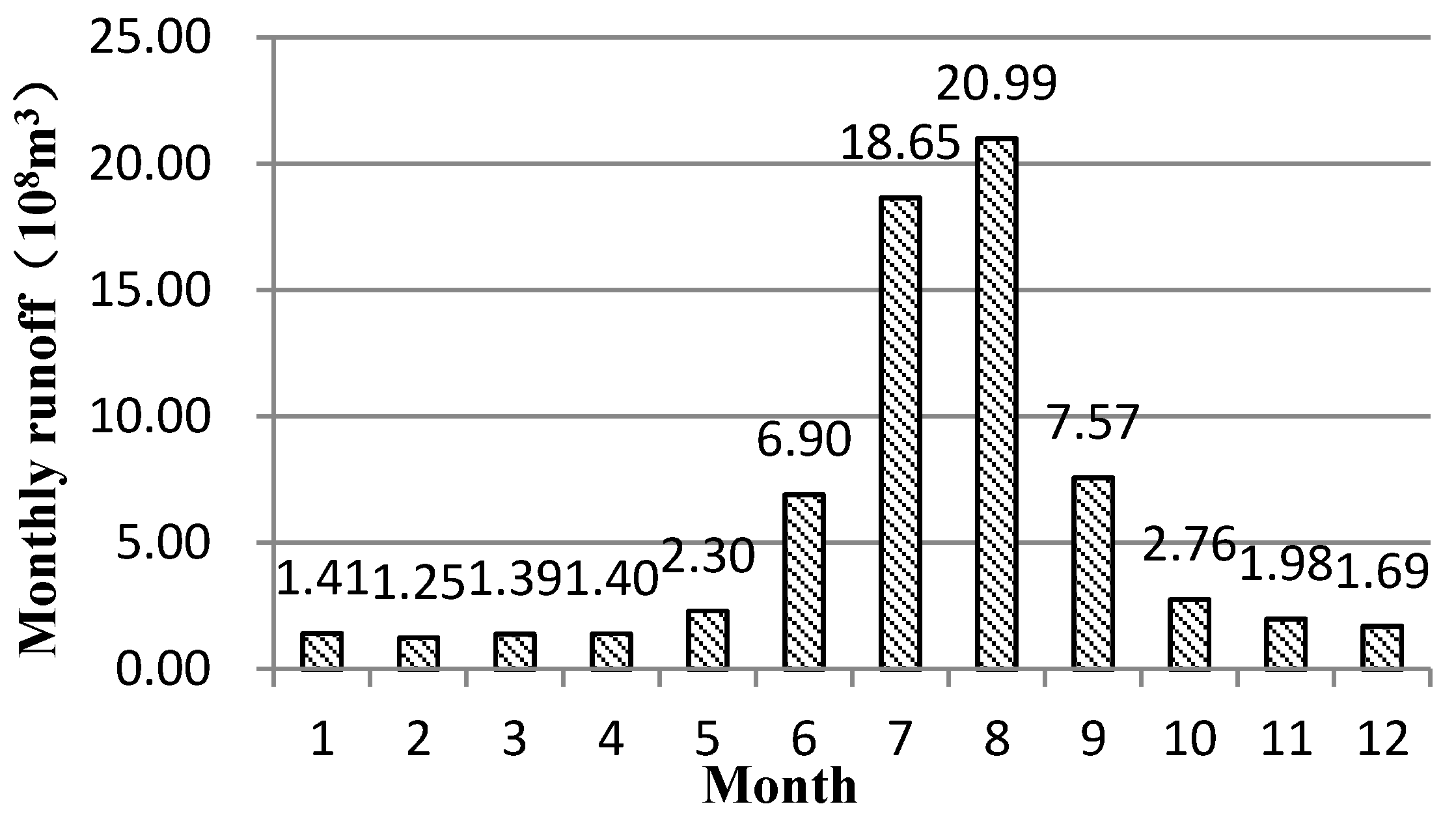Quantitative Determination of Some Parameters in the Tennant Method and Its Application to Sustainability: A Case Study of the Yarkand River, Xinjiang, China
Abstract
1. Introduction
2. Study Area and Methodology
2.1. Study Area
2.2. Data Collection
2.3. Calculation of BEEWR
3. Analysis and Results
3.1. Delineation of Flood and Non-Flood Seasons
3.2. Determination of the Ecological Base Flow Standard
3.3. Calculation of BEEWR for Other River Reaches
3.4. Case Study: Yarkand River Basin, Xinjiang, China
3.4.1. Determination of Flood and Non-Flood Seasons for the Yarkand River
3.4.2. Determination of the Ecological Base Flow Standard and BEEWR in Kaqun Section
3.4.3. Determination of BEEWRs in Other Sections
4. Discussion
5. Conclusions
Author Contributions
Funding
Acknowledgments
Conflicts of Interest
References
- Sun, Z.L.; Li, X.D. Evolution characteristics and development potential of grain production in Africa under the sustainable development goals of UN. J. China Agric. Univ. 2020, 25, 160–170. [Google Scholar]
- Yang, S.M.; Shao, D.G.; Shen, X.P. Quantitative approach for calculating ecological water requirement of seasonal water–deficient rivers. Shuili Xuebao 2015, 36, 1341–1346. [Google Scholar]
- Wang, R.H.; Song, Y.D.; Fan, Z.L.; Ma, Y.J. Estimation on ecological water demand amount in four sources and one main stream area of Tarim Basin. J. Soil Water Conserv. 2001, 15, 19–22. [Google Scholar]
- Ni, J.R.; Cuo, S.B.; Li, T.H.; Jin, L. Water demand for river ecological environment. Shuili Xuebao 2002, 14–19. [Google Scholar] [CrossRef]
- Ling, H.B.; Guo, B.; Xu, H.L.; Fu, J.Y. Configuration of water resources for a typical river basin in an arid region of China based on the ecological water requirements (EWRs) of desert riparian vegetation. Glob. Planet. Ch. 2014, 122, 292–304. [Google Scholar] [CrossRef]
- Lytle, D.A.; Poff, N.L. Adaptation to natural flow regimes. Trends Ecol. Evol. 2004, 19, 94–100. [Google Scholar] [CrossRef]
- Meijer, K.S.; Krogt, W.N.M.; Beek, E. A new approach to incorporating environmental flow requirements in water allocation modeling. Water Resour. Manag. 2012, 26, 1271–1286. [Google Scholar] [CrossRef]
- Gu, W.Q.; Shao, D.G.; Jiang, Y.F. Risk evaluation of water shortage in source area of middle route project for south-to north water transfer in China. Water Resour. Manag. 2012, 26, 3479–3493. [Google Scholar] [CrossRef]
- Dai, J.S. Evaluation of Eco-Environment and Socio-Economic Benefit on the Project of Comprehensive Reclamation in Tarim River Basin. Ph.D. Thesis, Xinjiang Agricultural University, Xinjiang, China, 2015. [Google Scholar]
- Nie, S.H. Method & effect of emergency water supply to the downstream of the Tarim River. South to North Water Transf. Water Sci. Technol. 2007, 5, 106–108. [Google Scholar]
- Weber, C.; Peter, A.; Zanini, F. Spatio-temporal analysis of fish and their habitat: A case study on a highly degraded Swiss river system prior to extensive rehabilitation. Aquat. Sci. 2007, 69, 162–172. [Google Scholar] [CrossRef]
- Zambrano, L.; Contreras, V.; Mazari-Hiriart, M.; Zarco-Arista, A.E. Spatial heterogeneity of water quality in a highly degraded tropical freshwater ecosystem. Environ. Manag. 2009, 43, 249–263. [Google Scholar] [CrossRef] [PubMed]
- Amrit, K.; Mishra, S.K.; Pandey, R.P. Coupling of Tennant concept with standardized precipitation index (SPI) for the prediction of environmental flow condition from rainfall in upper Narmada Basin. In Climate Change Impacts; Singth, V.P., Yadav, S., Yadava, R., Eds.; Water Science and Technology Library, Springer Nature Singapore Pte Ltd.: Singapore, 2018. [Google Scholar]
- Karakoyun, Y.; Yumurtaci, Z.; Donmez, A.H. Environmental flow assessment for energy generation sustainability employing different hydraulic evaluation methods: Cambasi hydropower plant case study in Turkey. Clean Technol. Environ. Policy 2016, 18, 583–591. [Google Scholar] [CrossRef]
- Karakoyun, Y.; Donmez, A.H.; Yumurtaci, Z. Comparison of environmental flow assessment methods with a case study on a runoff river-type hydropower plant using hydrological methods. Environ. Monit. Assess. 2018, 190, 722. [Google Scholar] [CrossRef] [PubMed]
- Ksiazek, L.; Wos, A.; Florek, J.; Wyrebek, M.; Mlynski, D.; Walega, A. Combined use of the hydraulic and hydrological methods to calculate the environmental flow: Wisloka River, Poland: Case study. Environ. Monit. Assess. 2019, 191, 254. [Google Scholar] [CrossRef] [PubMed]
- Xu, Z.X.; Li, P.; Hou, X.Y. Theoretical basis and estimation method for ecological base-flow. Yellow River 2019, 41, 119–127. [Google Scholar]
- Huang, K.; Li, H.E.; Cheng, B.; Tian, R.G. Application status and improvement ideas of river ecological base flow based on Tennant method. J. Water Resour. Water Eng. 2019, 30, 103–110. [Google Scholar]
- Wu, M.L. A review of calculation methods of ecological base flow. Water Conserv. Mong. 2019, 11, 52–53. [Google Scholar]
- Li, C.W.; Kang, L. A new modified Tennant method with spatial-temporal variability. Water Resour. Manag. 2014, 28, 4911–4926. [Google Scholar] [CrossRef]
- Chen, Y.N.; Chen, Z.S.; Li, B.F.; Li, Q.H. Response of runoff to climate change. In Water Resources Research in Northwest China; Springer: New York, NY, USA; London, UK, 2014; pp. 145–191. [Google Scholar]
- Zheng, H.L.; Yan, J.; Yuan, H.H. Analysis of temperature and precipitation of southern Xinjiang in last 58 years. J. Arid Land Resour Environ 2010, 24, 103–109. [Google Scholar]
- Tennant, D.L. Instream flow regimens for fish, wildlife, recreation and related environmental resources. In Instream Flow Needs; Orsborn, J.F., Allman, C.H., Eds.; American Fisheries Society: Bethesda, MD, USA, 1976; pp. 359–373. [Google Scholar]
- Wei, W.Y.; Liu, Z.H.; Feng, J.; Yang, J.M.; Wang, J.Z. A study of the estimation of the Hutubi River ecological base flow in the north slope of the Tianshan mountains. Water Conserv. Hydropower China 2017, 6, 92–96. [Google Scholar]
- Meng, H.Y. Calculation method of river ecological base flow and its applicability analysis. Basic Sci. 2013, 5, 135. [Google Scholar]
- Gao, Z.Y.; Feng, J.N.; Zhou, C.M.; Cui, J.G. Arid climate seasonal rivers deposition: A case of Lower Cretaceous in Kuche river outcrop. Acta Sedimentol. Sin. 2014, 32, 1060–1071. [Google Scholar]
- Yang, F.C.; Xia, Z.Q.; Yu, L.L.; Guo, L.D. Calculation and analysis of the instream ecological flow for the Irtysh River. Proced. Eng. 2012, 28, 438–441. [Google Scholar] [CrossRef]
- Hu, A.Y. Study on Hydro-Eco Characteristics and Rational Utilization of Water Resources in the Continental River of Arid Area. Doctoral Dissertation, Chang’an University, Xi’an, China, 2003. [Google Scholar]
- Kumar, P.; Liu, W.; Chu, X.; Zhang, Y.; Li, Z.H. Integrated water resources management for an inland river basin in China. Watershed Ecol. Environ. 2019, 1, 33–38. [Google Scholar] [CrossRef]
- Chen, Y.N.; Chen, Y.P.; Zhu, C.G.; Li, W.H. The concept and mode of ecosystem sustainable management in arid desert areas in northwest China. Acta Ecol. Sin. 2019, 39, 7410–7417. [Google Scholar]
- Long, A.H.; Wei, X.N.; Zhang, J.; Hai, Y.; Liu, J.; Wang, Y.Y.; Yu, J.W. Analysis of ecological water consumption and its variation in inland river regions in Xinjiang in recent 16 years. Water Conserv. Hydropower China 2019, 50, 170–177. [Google Scholar]
- Chen, H.J.; Yang, J.P.; Tan, C.P. Estimating runoff variation in the future in a typical inland river based on the probability distribution method. J. Glaciol. Geocryol. 2019, 41, 1–9. [Google Scholar]
- Yang, F.D.; Zhang, Y.S. Study on eco-environmental water demand of seasonal rivers in northwest China. Water Plan. Des. 2018, 8, 72–74. [Google Scholar]


| Qualitative Description of Habitat | Base Flow Standard (Average Annual Natural Flow Percentage) | |
|---|---|---|
| Non-Flood Season | Flood Season | |
| Greatest | 200 | 200 |
| Best | 60–100 | 60–100 |
| Excellent | 40 | 60 |
| Very good | 30 | 50 |
| Good | 20 | 40 |
| Medium good | 10 | 30 |
| Poor | 10 | 10 |
| Extremely poor | 0–10 | 0–10 |
| Month | 1 | 2 | 3 | 4 | 5 | 6 | 7 | 8 | 9 | 10 | 11 | 12 |
|---|---|---|---|---|---|---|---|---|---|---|---|---|
| Temperature (℃) | −7.69 | −1.63 | 7.58 | 15.68 | 21.19 | 25.33 | 27.04 | 25.58 | 20 | 11.51 | 2.34 | −5.52 |
| Value of increase in temperature (℃) | 6.06 | 9.21 | 8.1 | 5.51 | 4.14 | 1.71 | −1.46 | −5.58 | −8.49 | −9.17 | −7.86 | |
| Rate of increase in runoffforevery one degree increase in temperature (%) | 9.98 | |||||||||||
| Rate of increase in monthly runoff (%) | 60 | 91 | 80 | 54 | 41 | 17 | −14 | −55 | −84 | −91 | −78 | |
| Month | Hetian River | Aksu River | Main Stream, Tarim River |
|---|---|---|---|
| January | 0.28 | 1.2 | 3.4 |
| February | 0.26 | 1.55 | 3.25 |
| March | 0.26 | 1.95 | 3.05 |
| April | 0.24 | 1.95 | 1.1 |
| May | 0.31 | 3.8 | 1.95 |
| June | 1.65 | 8.65 | 2.06 |
| July | 5.41 | 24.5 | 9.9 |
| August | 6.26 | 17.2 | 16.34 |
| September | 3.03 | 5.55 | 5.16 |
| October | 0.59 | 3.75 | 2.06 |
| November | 0.57 | 3.25 | 1.85 |
| December | 0.31 | 1.05 | 4.1 |
| Months | Yiganqi | 48th Mission Ferry | Alektamu | Heiniyazi |
|---|---|---|---|---|
| 1 | 0.23 | 0 | 0 | 0 |
| 2 | 0.22 | 0 | 0 | 0 |
| 3 | 0.22 | 0 | 0 | 0 |
| 4 | 0.21 | 0.13 | 0 | 0 |
| 5 | 0.26 | 0.16 | 0 | 0 |
| 6 | 1.25 | 1.17 | 1.02 | 0.07 |
| 7 | 4.41 | 2.54 | 1.57 | 0.35 |
| 8 | 5.26 | 2.63 | 1.51 | 1.45 |
| 9 | 2.99 | 1.81 | 1.73 | 0 |
| 10 | 0.55 | 0 | 0 | 0 |
| 11 | 0.54 | 0 | 0 | 0 |
| 12 | 0.25 | 0 | 0 | 0 |
| Total | 16.39 | 8.44 | 5.83 | |
| Flood season | 11.18 | 6.50 | 4.10 | 1.87 |
| Non-flood season | 5.21 | 1.94 | 1.73 | 0 |
© 2020 by the authors. Licensee MDPI, Basel, Switzerland. This article is an open access article distributed under the terms and conditions of the Creative Commons Attribution (CC BY) license (http://creativecommons.org/licenses/by/4.0/).
Share and Cite
Fu, A.; Wang, Y.; Ye, Z. Quantitative Determination of Some Parameters in the Tennant Method and Its Application to Sustainability: A Case Study of the Yarkand River, Xinjiang, China. Sustainability 2020, 12, 3699. https://doi.org/10.3390/su12093699
Fu A, Wang Y, Ye Z. Quantitative Determination of Some Parameters in the Tennant Method and Its Application to Sustainability: A Case Study of the Yarkand River, Xinjiang, China. Sustainability. 2020; 12(9):3699. https://doi.org/10.3390/su12093699
Chicago/Turabian StyleFu, Aihong, Yi Wang, and Zhaoxia Ye. 2020. "Quantitative Determination of Some Parameters in the Tennant Method and Its Application to Sustainability: A Case Study of the Yarkand River, Xinjiang, China" Sustainability 12, no. 9: 3699. https://doi.org/10.3390/su12093699
APA StyleFu, A., Wang, Y., & Ye, Z. (2020). Quantitative Determination of Some Parameters in the Tennant Method and Its Application to Sustainability: A Case Study of the Yarkand River, Xinjiang, China. Sustainability, 12(9), 3699. https://doi.org/10.3390/su12093699




